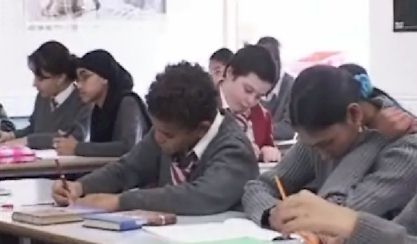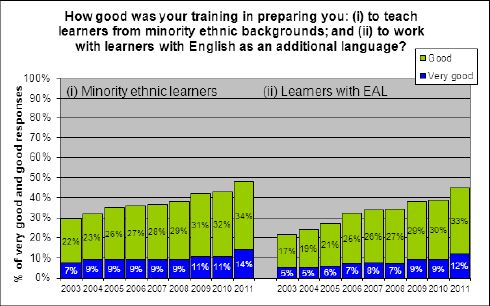
Supporting teachers to respond to bilingual pupils' learning needs is a key task for all teacher educators. The twentieth century saw significant global movements of communities which have had important effects on teaching and learning in schools in the U.K. In England more than one in seven pupils are learning English as an additional language (EAL) and their future achievement in the education system will be determined by their success in learning English.
The new teachers' standards apply to all teachers in England from September 2012, regardless of their career stage. They define the minimum level of practice expected of teachers from the point of being awarded QTS. Within these standards every teacher must: 'Adapt teaching to respond to the strengths and needs of all pupils' . They must 'have a clear understanding of the needs of all pupils, including those with special educational needs; those of high ability; those with English as an additional language; those with disabilities; and be able to use and evaluate distinctive teaching approaches to engage and support them'. (Standard 5).
EAL teaching and learning takes place within mainstream education but is also a distinct area of education. EAL is not a subject specialism in teacher training. The Teachers' Standards note what teachers should know about pupils learning EAL in the context of teaching all pupils. It is recognised within the teachers' standards that effectively supporting pupils with EAL requires teachers to employ distinctive teaching approaches. However, indications are that although the number of EAL learners in schools has risen by over 50% since 1997, specialist teacher expertise in schools is becoming increasingly rare.

While some institutions and bodies make excellent provision for equipping all student teachers with an awareness of the skills and knowledge required to support the learning of pupils with EAL, the area has been identified as one requiring further development. Although the most recent survey indicated that NQTs’ perceptions of their preparation to work with EALlearners have reached a nine-year high, only 45% of NQTs felt their training was good or very good in this respect.
EAL teaching and learning takes place within the mainstream and within all subjects. It is primarily about teaching and learning language through the content of the whole curriculum. In the past EAL has been regarded as a specific subject and continues to be viewed in this way in many other English speaking countries. However, currently EAL is considered an aspect of compulsory education and as a subject (ESOL) in post compulsory provision. As EAL does not currently have a separate syllabus in England it is more difficult to recognise as a distinct area of education. However, EAL has a knowledge base from theory and research and principled strategies for teaching in the mainstream context in a way which promotes language learning alongside content learning.
EAL teaching has links with English teaching as a mainstream subject, with modern foreign language teaching, and with English as a foreign language teaching, each of which are discrete subject areas, but EAL pedagogy is applied in all areas of the curriculum. The learning of EAL takes place as much in science, mathematics, humanities and the arts as it does in ‘subject’ English. It also takes place within the ‘hidden curriculum’. Beyond the school, it is affected by attitudes to race and culture in wider society. This is why all student teachers need to understand how EAL teaching and learning takes place in their classrooms and their schools.
This area of the website has been developed to provide support and guidance on EAL for all professionals involved in initial and continuing teacher education.